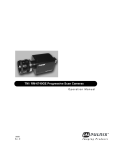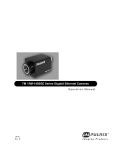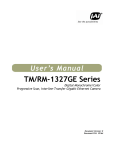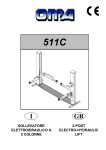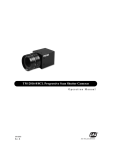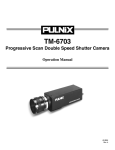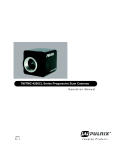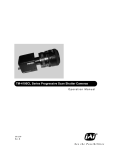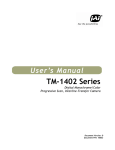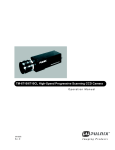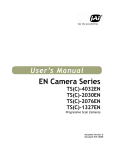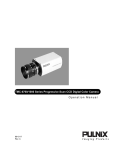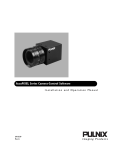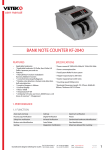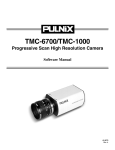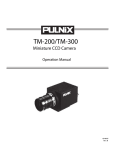Download User manual
Transcript
TM-4100GE Progressive Scan Shutter Cameras Operation Manual 10098 Rev. C Imaging Products i Notice Page Notice The material contained in this manual consists of information that is proprietary to JAI PULNiX, Inc., and may only be used by the purchasers of the product. JAI PULNiX, Inc. makes no warranty for the use of its product and assumes no responsibility for any errors which may appear or for damages resulting from the use of the information contained herein. JAI PULNiX, Inc. reserves the right to make changes without notice. Microsoft, Windows XP, Windows 2000, Windows 98, Windows NT, and Windows Explorer are either registered trademarks or trademarks of Microsoft Corporation in the United States and/or other countries. Warranty For information about the warranty, please contact your factory representative. Certifications CE Compliance The TM-4100GE camera has been certified to conform to the requirements of Council Directive 89/336/EC for electromagnetic compatibility and to comply with the following European Standards: Immunity: Emissions: EN 55024: 1998 + A1: 2001 + A2: 2003 EN 55022: 1998 + A1: 2000 + A2: 2003 All JAI PULNiX products bearing the CE mark have been declared to be in conformance with the applicable EEC Council Directives. However, certain factory-installed options or customer-requested modifications may compromise electromagnetic compatibility and affect CE compliance. Please note that the use of interconnect cables that are not properly grounded and shielded may affect CE compliance. Contact JAI PULNiX Applications Engineering Department for further information regarding CE compliance. FCC This equipment has been tested and found to comply with the limits for a Class A digital device, pursuant to Part 15 of the FCC Rules. These limits are designed to provide reasonable protection against harmful interference when the equipment is operated in a commercial environment. This equipment generates, uses and can radiate radio frequency energy and, if not installed and used in accordance with the instruction manual, may cause harmful interference to radio communications. Operation of this equipment in a residential area may cause harmful interference, in which case the user will be required to correct the interference at his own expense. WARNING Changes or modifications to this unit not expressly approved by the party responsible for FCC compliance could void the user’s authority to operate the equipment. SS O CIA TI O N S UL ® RM FILE # A3942 R E GI MEMBER A ISO-9001 FI TED IM MA O NG GI A AU T TM-4100GE Series Operation Manual JAI PULNiX, Inc. 625 River Oaks Parkway San Jose, CA 95134 Tel:(408) 383-0300 Tel:(800) 445-5444 Fax:(408) 383-0301 E-mail: [email protected] www.jaipulnix.com TE ED R JAI PULNiX, INC. TM-4100GE Progressive Scan Cameras iii Table of Contents 1 Software Introduction. . . . . . . . . . . . . . . . . . . . . . . . . . . . . . . . .1 1.1 1.2 1.3 1.4 Scope of the Document . . . . . . . . . . . . . . . . . . . . . . . . . . . . . . . . . . . 1 Related Documents. . . . . . . . . . . . . . . . . . . . . . . . . . . . . . . . . . . . . . . 1 Gigabit Ethernet Camera Interface. . . . . . . . . . . . . . . . . . . . . . . . . . . 1 Software Installation. . . . . . . . . . . . . . . . . . . . . . . . . . . . . . . . . . . . . . 2 1.4.1 1.4.2 1.4.3 1.4.4 1.4.5 Before Installing the GigE Series Camera-SDK Software . . . . . . . . . . . . . . Installing the Software . . . . . . . . . . . . . . . . . . . . . . . . . . . . . . . . . . . . . . . . . Installing the Software . . . . . . . . . . . . . . . . . . . . . . . . . . . . . . . . . . . . . . . . . Uninstalling the Software . . . . . . . . . . . . . . . . . . . . . . . . . . . . . . . . . . . . . . . Quick-Start . . . . . . . . . . . . . . . . . . . . . . . . . . . . . . . . . . . . . . . . . . . . . . . . . . 2 2 2 4 4 2 Connectors . . . . . . . . . . . . . . . . . . . . . . . . . . . . . . . . . . . . . . . . .7 2.1 Power and Signals Connector. . . . . . . . . . . . . . . . . . . . . . . . . . . . . . . 7 2.2 Ethernet. . . . . . . . . . . . . . . . . . . . . . . . . . . . . . . . . . . . . . . . . . . . . . . . 8 3 Configuring the TM-4100GE Camera . . . . . . . . . . . . . . . . . . . .9 3.1 Setup . . . . . . . . . . . . . . . . . . . . . . . . . . . . . . . . . . . . . . . . . . . . . . . . . . 9 3.2 Configuring the Imager . . . . . . . . . . . . . . . . . . . . . . . . . . . . . . . . . . . 11 3.2.1 GUI Features. . . . . . . . . . . . . . . . . . . . . . . . . . . . . . . . . . . . . . . . . . . . . . . . . 12 3.3 Configuring the Internal Frame Grabber . . . . . . . . . . . . . . . . . . . . . . 12 3.4 Modes . . . . . . . . . . . . . . . . . . . . . . . . . . . . . . . . . . . . . . . . . . . . . . . . . 12 3.4.1 Check the Current Camera Setting . . . . . . . . . . . . . . . . . . . . . . . . . . . . . . . . 3.4.2 Exposure Control . . . . . . . . . . . . . . . . . . . . . . . . . . . . . . . . . . . . . . . . . . . . . 3.4.3 Scan Mode . . . . . . . . . . . . . . . . . . . . . . . . . . . . . . . . . . . . . . . . . . . . . . . . . . 3.4.4 Gain Settings. . . . . . . . . . . . . . . . . . . . . . . . . . . . . . . . . . . . . . . . . . . . . . . . . 3.4.5 The Gain . . . . . . . . . . . . . . . . . . . . . . . . . . . . . . . . . . . . . . . . . . . . . . . . . . . . 3.4.6 Look-Up Table . . . . . . . . . . . . . . . . . . . . . . . . . . . . . . . . . . . . . . . . . . . . . . . 3.4.7 Memory Pages . . . . . . . . . . . . . . . . . . . . . . . . . . . . . . . . . . . . . . . . . . . . . . . 3.4.8 Free-Running Mode . . . . . . . . . . . . . . . . . . . . . . . . . . . . . . . . . . . . . . . . . . . 3.4.9 Externally Triggered . . . . . . . . . . . . . . . . . . . . . . . . . . . . . . . . . . . . . . . . . . . 3.4.10 Internally Triggered . . . . . . . . . . . . . . . . . . . . . . . . . . . . . . . . . . . . . . . . . . . 3.4.11 Save/Restore Settings to Your Hard Disk . . . . . . . . . . . . . . . . . . . . . . . . . . . 3.4.12 White Balance Control (Color Versions Only) . . . . . . . . . . . . . . . . . . . . . . . 3.4.13 Main Menu: “Option”. . . . . . . . . . . . . . . . . . . . . . . . . . . . . . . . . . . . . . . . . . 3.4.14 Version . . . . . . . . . . . . . . . . . . . . . . . . . . . . . . . . . . . . . . . . . . . . . . . . . . . . . 3.4.15 Exit . . . . . . . . . . . . . . . . . . . . . . . . . . . . . . . . . . . . . . . . . . . . . . . . . . . . . . . . 12 13 14 15 15 16 16 17 17 17 17 18 18 18 19 4 Signal Handling . . . . . . . . . . . . . . . . . . . . . . . . . . . . . . . . . . . . .20 4.1 4.2 4.3 4.4 4.5 Camera Inputs. . . . . . . . . . . . . . . . . . . . . . . . . . . . . . . . . . . . . . . . . . . 20 Camera Outputs . . . . . . . . . . . . . . . . . . . . . . . . . . . . . . . . . . . . . . . . . 20 GPIO Control Block . . . . . . . . . . . . . . . . . . . . . . . . . . . . . . . . . . . . . . 21 GPIO Label Table. . . . . . . . . . . . . . . . . . . . . . . . . . . . . . . . . . . . . . . . 23 Pulse Generators. . . . . . . . . . . . . . . . . . . . . . . . . . . . . . . . . . . . . . . . . 25 5 GigE Series Camera Serial Commands . . . . . . . . . . . . . . . . . . .26 6 Hardware Introduction . . . . . . . . . . . . . . . . . . . . . . . . . . . . . . . .31 iv 6.1 Product Description . . . . . . . . . . . . . . . . . . . . . . . . . . . . . . . . . . . . . . 31 6.2 Features. . . . . . . . . . . . . . . . . . . . . . . . . . . . . . . . . . . . . . . . . . . . . . . . 32 7 Installation . . . . . . . . . . . . . . . . . . . . . . . . . . . . . . . . . . . . . . . . .34 7.1 Getting Started . . . . . . . . . . . . . . . . . . . . . . . . . . . . . . . . . . . . . . . . . . 34 7.1.1 Unpacking Instructions . . . . . . . . . . . . . . . . . . . . . . . . . . . . . . . . . . . . . . . . . 34 7.1.2 Components . . . . . . . . . . . . . . . . . . . . . . . . . . . . . . . . . . . . . . . . . . . . . . . . . 34 7.1.3 Accessories and Options. . . . . . . . . . . . . . . . . . . . . . . . . . . . . . . . . . . . . . . . 34 7.2 Camera Setup . . . . . . . . . . . . . . . . . . . . . . . . . . . . . . . . . . . . . . . . . . . 35 7.2.1 7.2.2 7.2.3 7.2.4 7.2.5 Heat Dissipation . . . . . . . . . . . . . . . . . . . . . . . . . . . . . . . . . . . . . . . . . . . . . . Connector Pin Configurations . . . . . . . . . . . . . . . . . . . . . . . . . . . . . . . . . . . Power Supplies and Power Cable Setup . . . . . . . . . . . . . . . . . . . . . . . . . . . . Attaching the Camera Lens. . . . . . . . . . . . . . . . . . . . . . . . . . . . . . . . . . . . . . Adjustable Back-Focus . . . . . . . . . . . . . . . . . . . . . . . . . . . . . . . . . . . . . . . . . 35 35 36 38 38 8 Operation . . . . . . . . . . . . . . . . . . . . . . . . . . . . . . . . . . . . . . . . . .40 8.1 Progressive Scanning . . . . . . . . . . . . . . . . . . . . . . . . . . . . . . . . . . . . . 40 8.2 Bayer Color Filter (Color Versions) . . . . . . . . . . . . . . . . . . . . . . . . . . 41 8.2.1 8.2.2 8.2.3 8.2.4 8.2.5 8.2.6 8.2.7 8.3 8.4 8.5 8.6 Color Filter Array . . . . . . . . . . . . . . . . . . . . . . . . . . . . . . . . . . . . . . . . . . . . . Bayer Color Filter Array (CFA) . . . . . . . . . . . . . . . . . . . . . . . . . . . . . . . . . . Starting Pixel Configuration . . . . . . . . . . . . . . . . . . . . . . . . . . . . . . . . . . . . . Sync and Data . . . . . . . . . . . . . . . . . . . . . . . . . . . . . . . . . . . . . . . . . . . . . . . . Camera Functions . . . . . . . . . . . . . . . . . . . . . . . . . . . . . . . . . . . . . . . . . . . . . Interpolation Software . . . . . . . . . . . . . . . . . . . . . . . . . . . . . . . . . . . . . . . . . Color Interpolation . . . . . . . . . . . . . . . . . . . . . . . . . . . . . . . . . . . . . . . . . . . . 41 41 42 43 43 44 44 Electronic Shutter . . . . . . . . . . . . . . . . . . . . . . . . . . . . . . . . . . . . . . . . 44 Integration. . . . . . . . . . . . . . . . . . . . . . . . . . . . . . . . . . . . . . . . . . . . . . 45 External Sync . . . . . . . . . . . . . . . . . . . . . . . . . . . . . . . . . . . . . . . . . . . 45 Asynchronous Reset . . . . . . . . . . . . . . . . . . . . . . . . . . . . . . . . . . . . . . 45 8.6.1 Async No Shutter . . . . . . . . . . . . . . . . . . . . . . . . . . . . . . . . . . . . . . . . . . . . . 46 8.6.2 Internal Shutter Speed Control . . . . . . . . . . . . . . . . . . . . . . . . . . . . . . . . . . . 47 8.6.3 External VINIT With Pulse Width (No-Delay Shutter) and ROI (Read-out Inhibit) . . . . . . . . . . . . . . . . . . . . . . . . . . . . . . . . . . . . . . . . . . . . . 48 8.7 Dynamic Range Control . . . . . . . . . . . . . . . . . . . . . . . . . . . . . . . . . . 49 8.7.1 Programmable Look-Up Table (LUT) and Knee Control . . . . . . . . . . . . . . 50 8.8 Camera Timing Charts . . . . . . . . . . . . . . . . . . . . . . . . . . . . . . . . . . . . 51 9 Troubleshooting . . . . . . . . . . . . . . . . . . . . . . . . . . . . . . . . . . . . .55 9.1 Problems and Solutions . . . . . . . . . . . . . . . . . . . . . . . . . . . . . . . . . . . 55 9.1.1 Symptom: No Video . . . . . . . . . . . . . . . . . . . . . . . . . . . . . . . . . . . . . . . . . . . 55 9.1.2 Symptom: Dark Video . . . . . . . . . . . . . . . . . . . . . . . . . . . . . . . . . . . . . . . . . 55 9.1.3 Symptom: Non-Synchronized Video . . . . . . . . . . . . . . . . . . . . . . . . . . . . . . 55 9.2 Information and Support Resources . . . . . . . . . . . . . . . . . . . . . . . . . . 56 10 Appendix . . . . . . . . . . . . . . . . . . . . . . . . . . . . . . . . . . . . . . . . . .57 10.1 Specifications . . . . . . . . . . . . . . . . . . . . . . . . . . . . . . . . . . . . . . . . . . . 57 10.1.1 TM-4100GE Physical Dimensions . . . . . . . . . . . . . . . . . . . . . . . . . . . . . . . . 58 10.1.2 Spectral Response . . . . . . . . . . . . . . . . . . . . . . . . . . . . . . . . . . . . . . . . . . . . . 59 v List of Tables TABLE 1. TABLE 2. TABLE 3. TABLE 4. TABLE 5. Table 6. TABLE 7. TABLE 8. TABLE 9. TABLE 10. TABLE 11. TABLE 12. Hirose Connector, Pin Assignment . . . . . . . . . . . . . . . . . . . . . . . . . . . . . . . . . . . 7 GPIO Look-Up Table Input Labels . . . . . . . . . . . . . . . . . . . . . . . . . . . . . . . . . . 23 GPIO Look-Up Table Output Labels. . . . . . . . . . . . . . . . . . . . . . . . . . . . . . . . . 24 TM-4100GE Command List . . . . . . . . . . . . . . . . . . . . . . . . . . . . . . . . . . . . . . . 26 18 Bytes Status Report. . . . . . . . . . . . . . . . . . . . . . . . . . . . . . . . . . . . . . . . . . . . 28 12-Pin Connector . . . . . . . . . . . . . . . . . . . . . . . . . . . . . . . . . . . . . . . . . . . . . . . 35 Scan Mode . . . . . . . . . . . . . . . . . . . . . . . . . . . . . . . . . . . . . . . . . . . . . . . . . . . . . 41 Electronic Shutter Speeds . . . . . . . . . . . . . . . . . . . . . . . . . . . . . . . . . . . . . . . . . 45 Video Output . . . . . . . . . . . . . . . . . . . . . . . . . . . . . . . . . . . . . . . . . . . . . . . . . . . 53 External HD Locking and External VD Reset. . . . . . . . . . . . . . . . . . . . . . . . . . 54 Async Reset . . . . . . . . . . . . . . . . . . . . . . . . . . . . . . . . . . . . . . . . . . . . . . . . . . . . 54 TM-4100GE Camera Specifications Table . . . . . . . . . . . . . . . . . . . . . . . . . . . . 57 vi vii List of Figures Figure 1. Figure 2. FIGURE 3. FIGURE 4. FIGURE 5. FIGURE 6. FIGURE 7. FIGURE 8. FIGURE 9. FIGURE 10. FIGURE 11. FIGURE 12. FIGURE 13. FIGURE 14. FIGURE 15. FIGURE 16. FIGURE 17. FIGURE 18. FIGURE 19. FIGURE 20. FIGURE 21. FIGURE 22. FIGURE 23. FIGURE 24. Figure 24. Figure 25. FIGURE 26. FIGURE 27. FIGURE 28. FIGURE 29. FIGURE 30. FIGURE 31. FIGURE 32. FIGURE 33. FIGURE 34. FIGURE 35. Scanning for Drivers . . . . . . . . . . . . . . . . . . . . . . . . . . . . . . . . . . . . . . . . . . . . . . . Intel Pro Install Choices. . . . . . . . . . . . . . . . . . . . . . . . . . . . . . . . . . . . . . . . . . . . . Change and Remove Buttons. . . . . . . . . . . . . . . . . . . . . . . . . . . . . . . . . . . . . . . . . Network Device Finder Window . . . . . . . . . . . . . . . . . . . . . . . . . . . . . . . . . . . . . Select Camera Window . . . . . . . . . . . . . . . . . . . . . . . . . . . . . . . . . . . . . . . . . . . . . TM-4100GE Back Panel Connectors . . . . . . . . . . . . . . . . . . . . . . . . . . . . . . . . . . HR10A-10R-12P . . . . . . . . . . . . . . . . . . . . . . . . . . . . . . . . . . . . . . . . . . . . . . . . . . Ethernet GigE Socket. . . . . . . . . . . . . . . . . . . . . . . . . . . . . . . . . . . . . . . . . . . . . . . Camera Interface Application Dialog Box . . . . . . . . . . . . . . . . . . . . . . . . . . . . . . Advanced Configuration Window . . . . . . . . . . . . . . . . . . . . . . . . . . . . . . . . . . . . . Integrated GigE Camera Software . . . . . . . . . . . . . . . . . . . . . . . . . . . . . . . . . . . . . Advanced Configuration - Port Communication . . . . . . . . . . . . . . . . . . . . . . . . . . Exposure Control . . . . . . . . . . . . . . . . . . . . . . . . . . . . . . . . . . . . . . . . . . . . . . . . . Mode Control Pull-down . . . . . . . . . . . . . . . . . . . . . . . . . . . . . . . . . . . . . . . . . . . . Shutter Speed . . . . . . . . . . . . . . . . . . . . . . . . . . . . . . . . . . . . . . . . . . . . . . . . . . . . . Scan Mode . . . . . . . . . . . . . . . . . . . . . . . . . . . . . . . . . . . . . . . . . . . . . . . . . . . . . . . Offset Level . . . . . . . . . . . . . . . . . . . . . . . . . . . . . . . . . . . . . . . . . . . . . . . . . . . . . Look-Up Table . . . . . . . . . . . . . . . . . . . . . . . . . . . . . . . . . . . . . . . . . . . . . . . . . . . . Memory Pages . . . . . . . . . . . . . . . . . . . . . . . . . . . . . . . . . . . . . . . . . . . . . . . . . . . . White Balance Control Settings. . . . . . . . . . . . . . . . . . . . . . . . . . . . . . . . . . . . . . . GE Camera GPIO Control Block. . . . . . . . . . . . . . . . . . . . . . . . . . . . . . . . . . . . . . GPIO Look-Up Table. . . . . . . . . . . . . . . . . . . . . . . . . . . . . . . . . . . . . . . . . . . . . . . The GPIO Configuration . . . . . . . . . . . . . . . . . . . . . . . . . . . . . . . . . . . . . . . . . . . . Pulse Generator Page . . . . . . . . . . . . . . . . . . . . . . . . . . . . . . . . . . . . . . . . . . . . . . . 12-Pin Connector Pinouts . . . . . . . . . . . . . . . . . . . . . . . . . . . . . . . . . . . . . . . . . . . GigE Ethernet Connector. . . . . . . . . . . . . . . . . . . . . . . . . . . . . . . . . . . . . . . . . . . . 12P-02S Interface Cable (optional) . . . . . . . . . . . . . . . . . . . . . . . . . . . . . . . . . . . . Back-Focus Set-Screw Locations . . . . . . . . . . . . . . . . . . . . . . . . . . . . . . . . . . . . . Full Progressive Scan Mode (A) . . . . . . . . . . . . . . . . . . . . . . . . . . . . . . . . . . . . . . Bayer Color Filter Response . . . . . . . . . . . . . . . . . . . . . . . . . . . . . . . . . . . . . . . . . Example of Color CCD CFA Pattern. . . . . . . . . . . . . . . . . . . . . . . . . . . . . . . . . . . Example of TMC-4100GE (Same as TM-4100GE) . . . . . . . . . . . . . . . . . . . . . . . No-Delay Shutter . . . . . . . . . . . . . . . . . . . . . . . . . . . . . . . . . . . . . . . . . . . . . . . . . . Read-Out Inhibit . . . . . . . . . . . . . . . . . . . . . . . . . . . . . . . . . . . . . . . . . . . . . . . . . . Physical Dimensions . . . . . . . . . . . . . . . . . . . . . . . . . . . . . . . . . . . . . . . . . . . . . . . Spectral Response . . . . . . . . . . . . . . . . . . . . . . . . . . . . . . . . . . . . . . . . . . . . . . . . . 3 3 4 5 5 7 8 8 9 10 11 13 13 14 14 14 15 16 16 18 21 22 22 25 35 36 37 39 40 42 42 43 48 49 58 59 viii September 20, 2006 TM-4100GE Software Operation Manual 1 Software Introduction 1.1 Scope of the Document This manual describes how to access and use features specific to JAI PULNiX's Gigabit Ethernet camera, the TM-4100GE. The camera’s different operation modes are described in the hardware section of this manual, which begins on page 31. The TM-4100GE series consists of the TM-4100GE (monochrome) and the TMC-4100GE (color). Unless otherwise noted, all information contained in this manual is relevant to both models. 1.2 Related Documents The appendix contains descriptions of the TM-4100GE camera’s internal frame grabber and how to connect the camera. The appendix complements, and should be used in conjunction with the three following documents: • Cam2Net User’s Manual • Cam2Net IP Device Drivers • Cam2Net C++ SDK Reference Manual These documents are part of the GigE software package and are added to your system when the software is installed. 1.3 Gigabit Ethernet Camera Interface The GigE interface provides an easily connectable, high-bandwidth imaging solution, where video data is sent as IP packets over an industry-standard GigE network. TM-4100GE Software Page 2 Software Introduction Point-to-point (unswitched) transmission is up to 100 meters. With Gigabit Ethernet switches, the transmission distance is virtually unlimited. Note: Refer to the section on time-outs and packets in the Cam2Net User’s Manual for more information on packet sizes for point-to-point and networked applications. Communication with a GigE camera is completely transparent to the user, so if you are used to working with Camera Link® or the JAI Cam2Net adapter, you will find it very easy to migrate. The TM-4100GE camera has internal frame memory, which sends only the actual image data using the Gigabit Ethernet interface. At the PC, the Cam2Net Software Development Kit (SDK) provides a communications interface that maps the RS-232 command channel through the IP link. All commands sent to and received from the camera are transparently routed to/from the host PC via the GigE link. Refer to the Cam2Net User’s Manual for details about network requirements, compatibility, and so on. 1.4 Software Installation The following instructions explain how to install the JAI PULNiX GigE camera-control software on a PC. 1.4.1 Before Installing the GigE Series Camera-SDK Software Before installing the JAI PULNiX GigE camera-SDK software, please note the following requirements. • Your computer must have a Pentium processor running at least 1.4GHZ, and its operating system must be either Microsoft Windows XP Pro or Windows 2000. • Installation of the software requires approximately 75 MB of free space in your PC hard disk. 1.4.2 Installing the Software To install the JAI PULNiX GigE camera-SDK software, read and follow the directions included in the document download card. If your computer does not have Internet access, call JAI PULNiX at 1 800 445 5444 to request that the software be sent to you on a CD-ROM. Install the software using the following steps: 1.4.3 Installing the Software To install the JAI PULNiX GigE camera-control software, read and follow the directions included in the document download card. If your computer does not have Internet access, call JAI PULNiX at 1 800 445 5444 to request that the software be sent to you on a CD-ROM. Install the software using the following steps: 1. Open the folder “JAI” and run the IPEngineSDK.exe file to install the Camera Interface Application. TM-4100GE Software Page 3 Software Introduction 2. Open the folder “GigE_Software” and run the setup.bat file. This installs the GigE camera software as part of the Camera Interface Application. It copies the file cycampulnix.dll to the folder C:\Program Files\JAI\Cam2Net\Binaries. 3. The program initiates a driver scan. Allow the network card driver installation at this time. (If you cancel the installation for some reason this dialog box can be accessed at a later time; go to “Start” --> “Programs” --> “JAI AS” --> “Launch Driver Installation Tool” to launch the driver install). 4. A driver installation tool dialog box displays. Read the message about canceling found new devices and then click “OK”. Figure 1. Scanning for Drivers 5. The Driver Installation Tool dialog box appears with a listing of all NIC cards on the system. 6. Right click on the net driver desired for the camera. If the driver is an Intel Pro a high performance option is available for install. Figure 2. Intel Pro Install Choices 7. Right click on the net driver desired for the camera. 8. Select the desired driver install “Install High Performance IP Device Driver” or “Install Intel Network Driver”. The network installation options vary, based on the NIC card installed on the TM-4100GE Software Page 4 Software Introduction system. A dialog box asks for verification of the selected install. Click “Yes”. Follow the instructions on any additional dialog boxes. For information on other network card installs click “Start”-->”JAI A.S”-->”Cam2Net”-->”Documentation”-->”Cam2Net IP Device Drivers”. An Acrobat file has instruction to help guide you through the proper install. 9. 10. Go to “Start” --> “Programs” --> “JAI AS” --> “Cam2Net” --> “Launch Coyote application” to launch the camera control tool. 11. 1.4.4 Uninstalling the Software To uninstall the JAI PULNiX GigE camera-control software from the control panel, use the following steps: 1. Open “Add or Remove Programs” in the control panel. 2. Select “JAI Cam2Net” from the lists of the installed software. 3. Click the “Change or Remove” button as shown in Figure 1. FIGURE 3. 1.4.5 Change and Remove Buttons Quick-Start Use the following quick-start process when the Camera Interface Application is installed on your PC. 1. Connect the camera. The Hirose pin layout is shown in Table 1 on page 7. Both the Hirose and the network cable (RJ-45) are illustrated in Figure 6. 2. Run the Camera Interface Application. 3. Click “Detect.” Assign a suitable IP address to the camera. The window shown in Figure 2 appears. TM-4100GE Software Page 5 Software Introduction FIGURE 4. 4. Network Device Finder Window Select the appropriate camera from the list, similar to the window shown in Figure 3 and click OK. FIGURE 5. Select Camera Window 5. Go to the “Acquisition” tab and click Start. An image stream should appear. 6. Click on Configure and open the “GigE Camera Software” dialog box. This is your integrated control software. Note: the color version (TMC-4100GE) requires color interpolation to be performed in the frame grabber or by using the host computer’s CPU. In default mode, the camera supports 2 x 2 color interpolation. For better color performance, the user can select 3 x 3 interpolation in the Camera TM-4100GE Software Page 6 Software Introduction Interface Application. Go to the “Acquisition” tab and click Configure. In the Advanced Configuration Window, select the “Pixel Type” tab. Make sure the camera is set to the proper color space and pixel depth, then click the check-box labeled “Use 3 x 3 Bayer Interpolation” in the “Conversion Options” panel. More information on color interpolation and the color filter array (CFA) can be found in Section 8.2 beginning on page 38 of this manual. TM-4100GE Software Page 7 Connectors 2 Connectors The camera has two sockets, as shown in Figure 6 below: • 12-pin Hirose for power, trigger, RS-232 communication and TTL I/O. • RJ-45 for Gigabit Ethernet. FIGURE 6. TM-4100GE Back Panel Connectors GigE POWER These connectors are described in Section 2.1 and Section 2.2 below. 2.1 Power and Signals Connector The GE camera receives power and signal through a 12-pin Hirose connector. Table 1 lists the pin layout and describes the function of each pin. The table lists the GPIO assignments for the relevant pins. A magnified illustration of each pin’s assignment follows in Figure 7 on page 8. TABLE 1. Hirose Connector, Pin Assignment Pin # Definition Description GPIO Assignment 1 GND Power ground 2 +12V Power supply in 3 AGND Analog ground (video) 4 Reserved Reserved 5 GND Ground (TTL) - Digital 6 TTL IN (EXT_TRIG) INTG IN (CC2 equivalent) I0 7 TTL IN (EXT_VD) HD in (CC4 equivalent) I1 (can bypass GPIO LUT) 8 TTL OUT (STROBE) Strobe output Q0 9 TTL IN (EXT_HD) VD in (CC3 equivalent) I2 (can bypass GPIO LUT) 10 RESV Reserved 11 TTL IN (INTG_CON) Reserved 12 RESV Reserved I3 TM-4100GE Software Page 8 Connectors FIGURE 7. HR10A-10R-12P 9 1 2 8 10 11 3 4 12 5 7 6 2.2 Ethernet The GigE socket, marked on the camera’s back panel as “GigE,” is a standard RJ-45 Ethernet socket. Use at least cat5e UTP cables (Cat6 cables are preferred). If you wish to connect the camera directly to a PC, you must use a cross-over cable. Refer to the Cam2Net User's Manual for details.1 FIGURE 8. Ethernet GigE Socket GigE 1. JAI PULNiX recommends the use of shielded cables to reduce emissions and for CE/FCC compliance. Double-shielded cables will further reduce emissions. TM-4100GE Software Page 9 Configuring the TM-4100GE Camera 3 Configuring the TM-4100GE Camera The configuration of your GigE camera consists of two parts: • The imager configuration (CCD and control circuits) • The internal frame grabber configuration The imager can be configured for partial scan, binning, and so on, just like a Camera Link camera. The internal frame grabber is automatically configured for the pixel type, windowing, image size, I/O and so on, by the GigE camera software. 3.1 Setup If you have a peer-to-peer connection between the TM-4100GE camera and your PC without network switches, your packet size can be the default value (8128 bytes) as shown in Figure 7. However, if you are connecting the TM-4100GE to your PC through a network switch, then you need to know the maximum packet size that your network switch supports. Typically, if your switch supports jumbo packets, then you should keep the packet size to 8128 bytes. If your switch does not support jumbo packets, then you may need to change the packet size to 1440 bytes. FIGURE 9. Camera Interface Application Dialog Box Note: If you connect the camera through a network switch, you may need to modify the packet size. TM-4100GE Software Page 10 Configuring the TM-4100GE Camera To use the integrated GigE camera software, use the following steps: 1. Start the Camera Interface Application. The dialog box shown in Figure 9 appears. 2. Click the Detect button to detect the device and driver in the “Device Actions” panel. 3. Click Select Camera and select TM-4100GE or TMC-4100GE (color) from the camera list. 4. Select the “Acquisition” tab and click Configure. The camera configuration dialog box displays. 5. Select the “GigE Camera Software” tab. This is the Integrated GigE Camera Software shown in Figure 11 on the next page. The TM-4100GE camera can operate in either 8-bit or 10-bit digital output mode. The 8-bit/10-bit selection is possible through the GigE integrated software. To select the mode, open the Configure page and select the Pixel Type tab. Under the Pixel Type, select either Grayscale 8, or Grayscale 10. Note that when Grayscale 10, 2 taps is selected, the LUT (Look-Up Table) is not available in this mode. FIGURE 10. Advanced Configuration Window TM-4100GE Software Page 11 Configuring the TM-4100GE Camera 3.2 Configuring the Imager To configure the TM-4100GE’s imager, use the integrated GigE camera software that is part of the Cam2Net Camera Interface Application. You can also use the dual-tap AccuPiXEL GigE control tool, but that will not update any internal grabber settings. “Hardware Introduction” on page 27 of this manual contains a description of the different image settings of the camera. FIGURE 11. Integrated GigE Camera Software TM-4100GE Software Page 12 Configuring the TM-4100GE Camera 3.2.1 GUI Features You can control the following camera functions using the integrated camera software. • Shutter Speed and Mode • Scan Mode • Gain Control • Offset Level • Memory Pages • LUT (Look-Up Table) Control 3.3 Configuring the Internal Frame Grabber The integrated camera software updates the internal frame grabber settings automatically. In addition, because the internal frame grabber configuration is independent of the imager configuration, you can set up (that is, “window”) the internal frame grabber separately, for example, the Image Settings tab in the integrated camera software. This has the added benefit of reducing unnecessary traffic on the GigE network, hence freeing bandwidth for other cameras. 3.4 Modes This section includes examples of various types of setup actions available through the camera configuration dialog box. 3.4.1 Check the Current Camera Setting You can manually send camera commands from the “Serial Free From” tab of the Configuration window shown in Figure 12. Use the serial port and click the “CR” check box. Enter :RPST and click Send to get the current camera setting. For detailed information about the current camera setting, refer to Table 4 on page 26. TM-4100GE Software Page 13 Configuring the TM-4100GE Camera FIGURE 12. Advanced Configuration - Port Communication 3.4.2 Exposure Control In Exposure Control, under the GigE Camera software tab, shown in Figure 13, you can specify the shutter mode and set the shutter speed and direct shutter values. FIGURE 13. Exposure Control TM-4100GE Software Page 14 Configuring the TM-4100GE Camera Shutter Mode Use the pull-down menu shown in Figure 14. to select from Manual or Async mode. FIGURE 14. Mode Control Pull-down Shutter Speed The shutter speed setting, shown in Figure 15, allows you to select the specific shutter speed for manual shutter and Async shutter. Manual shutter speed 0 is No Shutter mode; Async shutter speed 0 is Async No Shutter mode; Async shutter speed 9 is Async - No Delay shutter mode (pulse width control). Direct Shutter allows you to select shutter speed for direct shutter count by the video line. Please note that manual shutter 1 and 2 are not available in scan mode B and D. FIGURE 15. Shutter Speed 3.4.3 Scan Mode The TM-4100GE camera has full and partial scan modes as shown in Figure 16. The partial scan area allows you to select the different scan lines. When the scan area starts from an odd line, for a color camera, an offset of 1 is added in the vertical direction. The TM-4100GE camera has no binning modes. FIGURE 16. Scan Mode TM-4100GE Software Page 15 Configuring the TM-4100GE Camera 3.4.4 Gain Settings 3.4.4 (a) Gain The Gain Settings control box, shown in Figure , allows you to change the Gain value from 2.97dB to 21.96 dB. To change the value, move the slider or enter the value directly into the text box. 3.4.4 (b) Gain Channel Balance Control Click the “Channel Balance” button to enable gain channel balancing. Once gain channel balancing has finished, the software disables this feature automatically. Please note that when channel balancing, channel B aligns to channel A. Good channel balance is obtained by exposing the camera to a uniform light source under 80% saturation. If the camera is in Async trigger mode and the trigger frequency is low (or slow), it may take longer to collect enough frames to balance the channel. Another condition in which Channel Balance may not work properly is when you use the high-speed shutter under lowfrequency light, such as fluorescent light. In both cases, the channel balance will time-out in 10 seconds if the balance is not reached. 3.4.5 The Gain Offset Level The Channel A offset level is master, the channel B is slave. The offset level box, shown in Figure 17, allows you to change Channel A offset voltage. To change the value, move the slider or enter the value directly into the box. The camera itself automatically adjusts Channel B offset voltage, every other frame. Please note that offset level control is not available in scan modes C and D. FIGURE 17. Offset Level TM-4100GE Software Page 16 Configuring the TM-4100GE Camera 3.4.6 Look-Up Table The look-up table (LUT) control, shown in Figure 18, allows you to change two knee point values. FIGURE 18. Look-Up Table Enter X1, Y1, X2, Y2 values directly to adjust the knee curve. In the integrated camera software, the look-up table can also be controlled interactively. The Table Selection pull-down menu allows you to select the Linear or Gamma 45 option. This control also allows you to check the positive or negative box to choose an image option. 3.4.7 Memory Pages All the camera parameters such as shutter mode, shutter speed, gain, offset level, scan mode, and LUT can be saved into seven available memory pages on the EEPROM in the camera. The pages are numbered 0-6. The Load Page button loads the corresponding camera settings from the EEPROM while the write page button writes the current camera settings to the corresponding memory page in the EEPROM. Page 1, shown in Figure 19, is the power-up default page. Page 0 is the factory default. To save your current camera settings for power up default, write the settings to memory page 1. FIGURE 19. Memory Pages To reset memory page 1 to the factory default settings, load memory page 0 and save those settings to memory page 1. Page 0 is password-protected and you cannot write to it. If you find that you do need to write to page 0, contact JAI PULNiX for password access. TM-4100GE Software Page 17 Configuring the TM-4100GE Camera Note: Configurations such as grabber settings, pulse generator, GPIO, and image setting must be saved into the XML file. Refer to Section 3.4.1, “Check the Current Camera Setting,” on page 12 for more information. 3.4.8 Free-Running Mode The camera must be in “Manual Shutter” or “Direct Shutter” mode. In the example below, there is no partial scan. 1. Connect to the camera. 2. Under the “Device Features” tab, set the GPIO look-up table to Q5=1. 3. Under the “GigE Software” tab, change the manual shutter or direct shutter values. 4. Click Start. You should now see a free-running video stream. 3.4.9 Externally Triggered The external trigger is sent through pin 6 of the 12-pin Hirose connector. To use the software to enable the external trigger, use the following steps: 1. Change the GigE camera software shutter mode to Async. Shutter. 2. Set the GPIO look-up table to Q4 = I0 and Q5 = 1. 3.4.10 Internally Triggered The camera-control software includes pulse generators that you can use to trigger the camera internally. To do this, use the following steps: 1. Select “Pulse Generator 0” under the “Device Features” tab. Set the pulse width and delay and check the “Periodic” option if needed. 2. Set the GPIO look-up table to Q5=1 and Q4=I7. 3. Set the shutter mode in the GigE camera software page to async shutter. For more information, refer to Section 3.4.2, “Exposure Control,” on page 13. 3.4.11 Save/Restore Settings to Your Hard Disk To save your current settings into the XML file, go to the main menu, select “File” and click on Save As. The XML file saves all your configurations such as grabber settings, pulse generator, GPIO and language settings. The XML file will not, however, save camera parameters such as shutter mode, shutter speed, gain settings, offset level, scan mode, and LUT. For more information about saving these camera parameters, please refer to Section 3.4.7, “Memory Pages,” on page 16. TM-4100GE Software Page 18 Configuring the TM-4100GE Camera 3.4.12 White Balance Control (Color Versions Only) To determine white balance, use the following steps: 1. Select scan mode A and no binning in the GigE Camera Software tabbed dialog. shown in Figure 11 on page 11. 2. Start the live video by clicking Start in the Acquisition tab of the Camera Interface Application dialog box. 3. Select “Color Adjustment” under tools in the main menu. Show the camera a piece of white paper to make sure that the image is not saturated. 4. Click Analyze to automatically calculate the white balance. 5. Once white balance has been calculated, click Apply Results to apply white balance. You can also assign custom gain and offset values to the R, G, and B channels. If you choose to assign custom values, click Apply Results. FIGURE 20. White Balance Control Settings. Custom white balance. Gain/Offset Automatic white balance control. 3.4.13 Main Menu: “Option” 3.4.13 (a) Test Pattern The Grabber Settings tabbed dialog box has a check box to enable the test pattern that is internally generated by the integrated camera software. 3.4.14 Version View the version number of the Cam2Net camera interface application by clicking on Help--> About. The version number of the integrated GigE camera software is seen in a text box control called “Version” in the GigE Camera tabbed dialog box. TM-4100GE Software Page 19 Configuring the TM-4100GE Camera 3.4.15 Exit From the main menu, select “File,” and click “Exit” to exit the software. TM-4100GE Software Page 20 Signal Handling 4 Signal Handling This section briefly describes the signal handling of the GE cameras in the following sections: • “Camera Inputs” on page 19 • “GPIO Control Block” on page 20 • “GPIO Look-Up Table” on page 22 • “GPIO Label Tables” on page 22 • “Pulse Generators” on page 24 Refer to the Cam2Net User’s Manual for additional details. 4.1 Camera Inputs For information on the polarity and type of the signals required to support specific camera functions, refer to “Asynchronous Reset” on page 39. The TM4100GE has four externally controllable standard signals: • Trigger (VINIT or EXT_TRIG) (CC1 equivalent) • Integration Control (INTEG/ROI) (CC2 equivalent) • VD in (EXT_VD) (CC3 equivalent) • HD in (EXT_HD) (CC4 equivalent) The labels for these signals in the GPIO Control Block programming language are: • I0, for VINIT (must be configured as EXT_TRIG) • I1, for VD in (must be configured as EXT_VD) • I2, for HD in (must be configured as EXT_HD) • I4, for Integration control (must be configured as INT) For normal exposure operation, the INTEG signal must be high. In the GPIO lookup table language: Q5=1. When it is low, the CCD readout is inhibited. To use the Integration Control, set Q5=I3 in the GPIO lookup table. 4.2 Camera Outputs When the Asynchronous Trigger is used, the strobe output indicates the exposure period. • I-4 for strobe output (must be configured as CAM_STROBE) TM-4100GE Software Page 21 Signal Handling 4.3 GPIO Control Block Figure 21 below shows the GPIO Control Block signals for the GE Cameras. FIGURE 21. GE Camera GPIO Control Block EXT_VD EXT_HD TTLIN(EXT_TRIG) FDV TTLIN(EXT_VD) LDV CTRL2 I0 Q0 Q1 I1 Q2 Q3 Q4 I2 TTLIN(EXT_HD) CTRL1 TTLN(INT) CAM_STROBE I3 I4 CTRL0 I5 I6 I7 pulse_out0 pulse_out1 pulse_out2 pulse_out3 LUT 8-to-16 TTLOUT(STROBE) EVINIT Q5 Q6 Q7 Q8 Q9 Q10 Q11 Q12 Q13 INTG_CON Q14 Q15 Pulse_Gen0 Pulse_Gen1 Pulse_Gen2 Pulse_Gen3 TRIG RESV pulse_trig0 pulse_trig1 pulse_trig2 pulse_trig3 Inputs I0 through I7 can be either external or internal inputs to the look-up table. The outputs are used by the imager part of the GE camera. The HD and VD signals can be passed through, bypassing the GPIO lookup table. Figure 23 on page 22 shows a screen dump of the GPIO function select page, where HD/VD bypass selection can be made. The default value 0 (zero) is through the lookup table. Value 1 (one) is bypassing the lookup table. The SDK and the Cam2Net Camera Interface Application both supply methods to select GPIO bypass of the external VD and HD (I1 and I2). It is also possible to select which signal source to lead to the GPIO inputs. This is done in the GPIO look-up table page as shown in Figure 22. TM-4100GE Software Page 22 Signal Handling FIGURE 22. GPIO Look-Up Table Q0 = I4 FIGURE 23. The GPIO Configuration TM-4100GE Software Page 23 Signal Handling 4.4 GPIO Label Table Table 2 shows which GPIO inputs carry the different signals. The top line for each label contains the default signal. TABLE 2. Input Label I0 I1 I2 I3 I4 I5 I6 I7 GPIO Look-Up Table Input Labels Signal TTL_IN(EXT_TRIG) FDV TTL_IN(EXT_VD) LDV CTRL2 TTL_IN(EXT_HD) CTRL1 TTL_IN(INT) Description TTL-input 0. Used for external trigger. Internal signal. Frame Data Valid. TTL-input 1. Used for external vertical drive. Internal signal. Line Data Valid. Internal control signal. TTL-input 2. Used for external horizontal drive. Internal control signal. TTL-input 3. Used for external integration control. CAM_STROBE Internal signal. Strobe Input. PULSE_GEN3 Pulse Generator 3 signals go here. CTRL0 Internal control signal. PULSE_GEN2 Pulse Generator 2 signals go here. PULSE_GEN1 Pulse Generator 1 signals go here. N/A PULSE_GEN0 Pulse Generator 0 signals go here. N/A TM-4100GE Software Page 24 Signal Handling Table 3 shows which output labels carry the output signals. TABLE 3. GPIO Look-Up Table Output Labels Output label Signal Q0 TTL-OUT(STROBE) Q1 N/A Q2 N/A Q3 N/A Q4 EVINIT Q5 INTG_CON Q6 EXT_VD Vertical Drive Q7 EXT_HD Horizontal Drive Q8 pulse_trig1 Pulse Generator 1 gets its trigger here Q9 pulse_trig0 Pulse Generator 0 gets its trigger here Q10 pulse_trig3 Pulse Generator 3 gets its trigger here Q11 pulse_trig2 Pulse Generator 2 gets its trigger here Q12 N/A Q13 N/A Q14 TRIG Trigger for camera’s internal frame grabber Q15 RESV Reserved TM-4100GE Software Description Strobe output Trigger Integration control Page 25 Signal Handling 4.5 Pulse Generators The TM-4100GE camera has four independently programmable pulse generators. These generators can run as either periodic or triggered. To run the pulse generators as triggered, they can be triggered on either levels or signal edges. These generators can be tied to the camera inputs (camera-control lines). For example, you can set pulse generator 0 in the Device Features tabbed dialog box to the following values: Delay = 600 Width = 14,000 Granularity = 1 Now check the Periodic option and change the camera settings to Async 9. This triggers the camera, based on the pulse width set in the Pulse Generator page. Be careful with the pulse generator’s GPIO input and output polarity. If the delay and pulse-width duration are switched around, the output polarity must be negated in the GPIO lookup table. The pulse generators are configured in the “Pulse Generator” section of the “Device Features” tab of the Advanced Configuration window as shown in Figure 24. FIGURE 24. Pulse Generator Page TM-4100GE Software Page 26 GigE Series Camera Serial Commands 5 GigE Series Camera Serial Commands You can control the GigE series cameras by serial command either using RS-232 or Camera Link. The Start character is always “:” and the End character is always <CR> (return). For example, to set Asynchronous Pulse Width Mode, send the command :ASH=9<CR> to the camera. Table 4 lists serial commands that can be used to control the camera. TABLE 4. Command TM-4100GE Command List Parameters End of Command Ack Response Description Gain Control :MGA= DDD <cr> :o<cr> Set CDS gain for ch A (DDD = 042 ~ 1E8) :MGB= DDD <cr> :o<cr> Set CDS gain for ch B (DDD = 042 ~ 1E8) :MGA? <cr> :oGA[DDD]<cr> Enquire CDS gain for ch A :MGB? <cr> :oGB[DDD]<cr> Enquire CDS gain for ch B :EABL <cr> :o<cr> Enable auto gain balance :DABL <cr> :o<cr> Disable auto gain balance :ABL? <cr> :oAB[N]<cr> Check if auto gain balance is enable (N = 1 Enable, N = 0 : Disable) ADC Reference Voltage Control :VRA= DDD <cr> :o<cr> Set reference voltage for ch A (XXX = 000 ~ 1FF) :VRB= DDD <cr> :o<cr> Set reference voltage for ch B (XXX = 000 ~ 1FF) :VRA? <cr> :oVA[DDD]<cr> Enquire reference voltage for ch A :VRB? <cr> :oVB[DDD]<cr> Enquire reference voltage for ch B Shutter Control :MSH= S <cr> :o<cr> Set Manual shutter (S = 0 ~ 9) :DSH= DDD <cr> :o<cr> Set Direct shutter (DDD = 000 ~ XXX*) :ASH= S <cr> :o<cr> Set Async shutter (S = 0 ~ 9) :ADS= DDD <cr> :o<cr> Set Async Direct Shutter (DDD=000-81F) <cr> :o[shtr]<cr> Enquire current shutter mode and number :SHR? TM-4100GE Software Page 27 GigE Series Camera Serial Commands TABLE 4. Command TM-4100GE Command List (Continued) Parameters End of Command Ack Response Description Lookup Table :GM45 <cr> :o<cr> Set gamma (.45) table :LINR <cr> :o<cr> Set linear table :KNEE= X1Y1X2Y2 <cr> :o<cr> Set knees (X1, Y1, X2, Y2 = 00 ~ FF) :SLUT N <cr> :o<cr> Set positive knee or negative knee (N = 0 : positive, M = 1 : negative) <cr> :o[lut]<cr> Enquire current LUT setting :LUT? Memory Pages :WRPG N <cr> :o<cr> Write Page N (N = 0 ~ 6; Page 0 is factory setting and not allowed to change by customer) :LDPG N <cr> :o[settings]<cr> Load Page N (N = 0 ~ 6) :RDPG N <cr> :o[settings]<cr> Read (Report) Page N (N = 0 ~ 6) Scan Mode :SMD M :SMD? <cr> :o<cr> Set Mode (M = A, B, C, D) <cr> :oMD[mode]<cr> Enquire current scan mode Miscellaneous :RPST <cr> :o[settings]<cr> Report Current Overall Settings <cr> :o<cr> Enable/Disable Test Pattern (N = 1 : Enable, N = 0 : Disable) :CAM? <cr> [CamMode] Enquire Camera Model :VER? <cr> [version] Enquire current version of firmware :TPTN N *. Maximum size is equal to the maximum line number of each scan mode. Note: If a command is not accepted for any reason, the camera will return a Nack response “:e”<cr> Report Command: RPST<cr> TS Return : O RR + “24 bytes” + <cr> TM-4100GE Software Page 28 GigE Series Camera Serial Commands TABLE 5. 18 Bytes Status Report Byte 1, 2 MGA Channel A Gain Control (H’042 - H’1E8) Byte 3, 4 VRA Channel A Offset Voltage (H’000 - H’1FF) Byte 5, 6 MGB Channel B Gain Control (H’042 - H’1E8) Byte 7, 8 VRB Channel B Offset Voltage (H’000 - H’1FF) Byte 9 Function Flag 0 Bit 7 output pixel order 1 Bit 6 output pixel order 0 “00”=<-“01”=<-- “10”=<-- Bit 5 Bit 4 Bit 3 Bit 2 “00” = Scan area A “01”=Scan area B “10”=Scan area C “11”=Scan area D Bit 1 Bit 0 Byte 10 Byte 11 Function Flag 1 Bit 7 ShutterMode2 “000”=Manual Shutter Bit 6 ShutterMode1 “001”=Async Shutter Bit 5 ShutterMode0 “011”=Direct Shutter Bit 4 Output Data Depth 0=8 bit 0=8bit; 1=10bit Bit 3 ShutterSpeed3 Bit 2 ShutterSpeed2 Bit 1 ShutterSpeed1 Bit 0 ShutterSpeed0 “0000” - “1001” Shutter Speed 0 - 9 Function Flag 2 Bit 7 LUTSIGN 0=Positive LUT; 1=Negative LUT Bit 2 LUTTABLE2 “000”=Linear LUT Bit 1 LUTTABLE1 “001”=Gamma.45 LUT Bit 0 LUTTABLE0 “010”=Two Knee Table Bit 6 Bit 5 Bit 4 Bit 3 TM-4100GE Software Page 29 GigE Series Camera Serial Commands TABLE 5. 18 Bytes Status Report (Continued) Byte 12 Function Flag 3 Bit 7 TESTPATTERN 0=Disable TP; 1=Enable TP Bit 6 PASSWORD 0=Disable PW; 1=Enable PW AUTOBALANCING 0=Disable AB; 1=Enable AB Bit 5 Bit 4 Bit 3 Bit 2 Bit 1 Bit 0 Byte 13 X1 Byte 14 Y1 Byte 15 X2 Byte 16 Y2 Byte 17 Reserved Byte 18 Reserved Byte 19 Reserved Byte 20 Reserved Byte 21, 22 Direct Shutter Byte 23, 24 Reserved (X1, Y1) Coordinate for Knee 1 (X1, Y1 = H’00 - H’FF) (X2, Y2) Coordinate for Knee 1 (X2, Y2 = H’00 - H’FF) H’000 - H’81F Total line number H’040 - H’1F3 TM-4100GE Software Page 30 GigE Series Camera Serial Commands TM-4100GE Software September 20, 2006 TM-4100GE Hardware Operation Manual 6 Hardware Introduction 6.1 Product Description The JAI PULNiX TM-4100GE series1 is a Gigabit Ethernet output, high-resolution progressive scan CCD camera. The interline-type CCD permits full vertical and horizontal resolution of very high speed shutter images and applications. The electronic shutter, which has speeds to 1/16,000 sec., can be reset asynchronously by external pulse control. The frame rate for a full image is 15 fps. A square imager format with uniform square pixels provides superior image definition in any orientation. On-chip micro lenses provide increased sensitivity. The TM-4100GE2 has a full dynamic range control function, which can be set at externally selectable look-up table (LUT) knee slopes to convert 10-bit input to 8-bit output, thereby optimizing the CCD’s full dynamic range in the normal output signal range. As a Gigabit Ethernet output camera, the TM4100GE has semi-auto-gain balancing functions. Applications for the TM-4100GE include machine vision, medical imaging, intelligent transportation systems, high-definition graphics, on-line inspection, gauging, character reading, archiving, and highsecurity surveillance. 1. Unless otherwise stated, all information in this manual applies to both cameras in the TM-4100GE series, the TM-4100GE and the TMC-4100GE. 2. The TM-4100GE is available with either 8-bit processing or 10-bit processing. You must specify your choice of configurations when you purchase the camera. TM-4100GE Hardware Page 32 Hardware Introduction 6.2 Features • Miniature size and light weight The printed circuit boards in the TM-4100GE have been arranged to create modular electronics, giving the camera flexibility. In addition, the use of miniature solid-state components results in a compact, lightweight camera that is 50.8mm x 50.8mm x 81.5mm in dimensions, and weighs only 155 grams. • Imager The TM-4100GE uses a dual-tap progressive scan interline transfer CCD that has the following features: - Resolution of 2k x 2k active pixels for excellent image quality. - 7.4 x 7.4 µm square pixels for precise dimensional measurement. - High-speed electronic shutter capability for high dynamic resolution of moving objects that eliminates the need for a mechanical shutter. - Progressive scan CCD eliminates interlace deterioration of image and increases ease of computer interface. - High sensitivity and low noise at fast scanning. The CCD has an excellent S/N ratio at the default setting that is greater than 48dB. - The CCD has a built-in microlens for increased quantum efficiency. • Electronic shutter The TM-4100GE has a substrate drain-type shutter mechanism which provides superb pictures at various speeds without smearing. For more information, please see Section 8.3, “Electronic Shutter,” on page 44. • Asynchronous reset The TM-4100GE captures async reset images and provides single-shot video output with single FDV. This makes it simpler for an ordinary frame grabber to capture the asynchronous reset images. The TM-4100GE’s asynchronous reset is flexible and accepts external horizontal drive (HD) for phase locking. When the VINIT (5V) pulse is applied to CC1, it resets the camera's scanning and purging of the CCD. The TM-4100GE has three modes to control the asynchronous reset and shutter speed: - Async, no shutter. The video signal and FDV are reset by external VINIT. - Internal shutter speed control. The speed control varies from 1/60 to 1/16,000 sec. The video signal and FDV starts with internal V reset timing related to shutter speed. - External VINIT with pulse width. The duration between pulse edges controls the shutter speed externally. TM-4100GE Hardware Page 33 Hardware Introduction • Output The TM-4100GE has a dual-tap 10-bit/8-bit Gigabit Ethernet output. • Dual-channel auto black level balancing and semi-auto gain balancing The TM-4100GE, as a dual-tap output camera, has auto black level balancing and semi-auto gain balancing functions. • Integration The TM-4100GE is capable of capturing high-resolution integration images. Its CCD imager can be exposed for longer than the normal scan timing of 1/15 sec. This integration feature provides extra sensitivity for applications in dark environments. The progressive scan imager permits a full frame of resolution in non-interlace format. Integration is achieved by applying INTEG signal to CC2 control of Gigabit Ethernet or by feeding VINIT pulse width control up to 1 sec of the pulse width in async pulse width control mode for the frames to be integrated. • Warranty Please contact your factory representative for details about the warranty. TM-4100GE Hardware Page 34 Installation 7 Installation The following instructions are provided to help you to set up your camera quickly and easily. We suggest that you read through these instructions before you unpack and set up your camera system. 7.1 Getting Started 7.1.1 Unpacking Instructions We recommend that you save the original packing cartons for the cameras and accessories in case you need to return or exchange an item. We also recommend that you bench-test any equipment being sent to another location for field installation to assure that everything is fully operational as a system. 7.1.2 Components When you receive your TM-4100GE camera from JAI PULNiX, the contents of the shipping box should include the camera and a document download card. If either of these items are missing, please contact your JAI PULNiX representative immediately. The document download card includes instructions and web locations for downloading the datasheet, manual, and camera-control software. If you do not have Internet access, please contact JAI PULNiX to receive this material on a CD-ROM. 7.1.3 Accessories and Options Following is a list of additional accessories and options that may be required for your application. Please check with your JAI PULNiX representative before you install your camera to determine what you might need. • PD-12U series power supply • 12P-02S power cable • Cat5e or cat6 shielded Ethernet cable (not supplied by JAI PULNiX) TM-4100GE Hardware Page 35 Installation 7.2 Camera Setup 7.2.1 Heat Dissipation The TM-4100GE is a compact 2k by 2k camera. Since all the electronics have been packed in a compact package, the outer case of the camera can become hot due to heat dissipation. For optimal performance, JAI PULNiX recommends using a cooling fan to set up a positive air flow around the camera and following the precautions below. • Mount the camera on a large heat sink (camera bracket) made out of heat-conductive material like aluminum. • Make sure the flow of heat from the camera case to the bracket is not blocked by a non-conductive material like plastic. • Make sure the camera has enough open space around it to facilitate the free flow of air. Please contact JAI PULNiX, Inc. at (800) 445-5444 or send an E-mail to [email protected] if you have any questions. 7.2.2 Connector Pin Configurations 7.2.2 (a) 12-Pin Connector The TM-1327GE has a 12-pin Hirose connector for power input and signal integration as shown in Figure 24. Figure 24. 12-Pin Connector Pinouts 1 2 3 9 8 10 11 4 7 12 5 6 Pin #1 is Ground and pin #2 is +12V DC. Table 6 shows the pin-out table. Table 6. 12-Pin Connector Pin Description Pin Description 1 GND 7 VD in 2 +12V DC 8 Strobe 3 GND (analog) 9 HD in 4 Reserved 10 Reserved 5 GND (digital) 11 Reserved 6 VINIT in 12 Reserved TM-4100GE Hardware Page 36 Installation 7.2.2 (b) Ethernet Connector The GigE socket, marked on the camera’s back panel as “GigE,” is a standard RJ-45 Ethernet socket as shown in Figure 25. Figure 25. GigE Ethernet Connector GigE Use at least cat5e UTP cables (cat6 cables are preferred). Refer to the Cam2Net User’s Manual for details. JAI PULNIX recommends the use of shielded cables to reduce emissions and for CE/FCC compliance. Double-shielded cables further reduce emissions. 7.2.3 Power Supplies and Power Cable Setup 7.2.3 (a) Power Supplies The TM-4100GE camera requires 12V DC power that is obtained through the 12-pin connector located on the rear panel of the camera. JAI PULNiX recommends the following power supplies: PD-12UU 100-240V AC/12V DC 1.2A universal voltage power supply, US Plug PD-12UUP PD-12UU with12-pin connector US plug PD-12UE PD-12UU European plug PD-12UEP PD-12UU with 12-pin connector European plug For users providing power through the 12-pin connector, the PD-12P, PD-12UEP and PD-12UUP power supplies are available with the 12-pin mating connector already attached to the leads from the power supply. The PD-12UU and PD-12UE power supplies can be connected to the JAI PULNiX power cable either directly or using a terminal strip. When wiring the PD-12UU and PD-12UE power supplies directly, please note the following: • The lead ends must be twisted together and tin-soldered for strength and electrical continuity. • Shrink tubing or a similar insulator should be used to prevent exposed leads from touching and shorting. • The +12V lead is marked with a red stripe or white lettering; be sure not to reverse the leads. • All connections must be properly insulated to prevent shorting. TM-4100GE Hardware Page 37 Installation 7.2.3 (b) JAI PULNiX Power Cables If you are using JAI PULNiX power cables such as the 12P-02S, please refer to the 12-pin connector pin-out diagram below. The cable pin-out diagram is shown in Figure 26. The color-coded leads use Gray for Ground and Yellow for +12V. FIGURE 26. 12P-02S Interface Cable (optional) +12 V GND (Gray) Power (Yellow) Video Out (Red Coax) HD In (White Coax) VD In (Black Coax) Male Analog Ch. A only } External sync input 12P-02S Interface Cable Pin# Lead Color Function Pin# Lead Color Function 1 Gray GND 7 Black coax TTL IN (EXT_VD) 2 Yellow +12V DC 8 White coax shield TTL OUT (STROBE) 3 Red coax shield AGND 9 White coax TTL IN (EXT_HD) 4 Red coax RESV 10 Brown RESV 5 Orange coax shield GND 11 Blue TTL IN (INTG_CON) 6 Orange coax TTL IN (EXT_TRIG) 12 Black coax shield RESV Note: Make sure that the unused leads are not touching and that there is no possibility that exposed wires could cause the leads to short. 7.2.3 (c) Building Your Own Power Cable Refer to the 12-pin connector pin-out in Figure 24 on page 35. Connect the Ground lead to pin #1, and the +12V DC lead to pin #2 of the 12-pin connector. Power must be DC-regulated, and of sufficient current to properly power the camera. 7.2.3 (d) Attaching the Power Cable to the Connector The 12-pin connector is keyed and will only fit in one orientation. Follow these directions to properly attach the power cable to the camera connector: 1. Rotate the connector while applying slight pressure until the keyways line up. 2. Press the connector into place until firmly seated. 3. Plug the power cord into the 100V AC socket. This powers-up the camera. TM-4100GE Hardware Page 38 Installation 7.2.4 Attaching the Camera Lens The TM-4100GE camera accepts 1.2" or larger format size C-mount lenses. To attach the C-mount lens1 to the camera, carefully engage the threads and rotate the lens clockwise until it firmly seats on the mounting ring. Do not force the lens if it does not seat properly. Please note that some lenses with extremely long flangebacks may exceed the mounting depth of the camera. 7.2.5 Adjustable Back-Focus Before cameras are shipped,back focus is carefully set using a collimator, oscilliscope and other specialized equipment. While the factory-set focus serves well in most cases, an adjustable back focus makes it possible to improve image sharpness when using lower-cost zoom lenses, custom optics, or in unusual parameters. There should be an obvious need to refocus the lens before attempting to change the back focus. This is a very exacting task. Some cameras have been returned to the factory to reset the back focus after failed attempts to change the focus by customers. It might be wise to label cameras whose back focus was adjusted 1. The camera must be connected to a monitor before attempting to adjust the back focus. 2. To back focus the camera, first attach a C-mount lens in the mount. Be certain that the lens is properly seated. 3. Next set the lens focus to infinity (if the lens is a manual iris, set the iris to a high f number while still retaining a well illuminated image). 4. Loosen the three miniature hex set-screws (use a 0.9 mm hex wrench) that lock the focus ring in place (two screws for a CS-mount). Slowly turn the lens and focus ring assembly back and forth until you obtain the best image of the desired object. This sets the back focus. Once the best image is obtained, tighten the focus ring set-screws until they are snug. Do not over-tighten the screws. Note: Mini-bayonet cameras adapted to C-mount do not have the back focus feature. 1. C-mount to F-mount and C-mount to K-mount adapters are available for larger format lenses (35mm). Check with local photography dealers for these lens adapters. TM-4100GE Hardware Page 39 Installation FIGURE 27. Back-Focus Set-Screw Locations Loosen the three 2mm screws around the perimeter of the C-mount lens collar (two 2mm screws for a CS-mount) to adjust the back focus. Unless you absolutely must, do not attempt to adjust this focus. TM-4100GE Hardware Page 40 Operation 8 Operation 8.1 Progressive Scanning Standard TV-system scanning is 525 lines interlace scanning as specified in the RS-170 protocol. Every other horizontal line (odd lines and even lines) is scanned at a 60Hz rate per field, and the scanning is completed with two fields (one frame) at 30Hz rate. Because of the interlace scanning, the vertical resolution of CCD cameras is limited at 350 TV lines, regardless of the horizontal resolution. When electronic shutter is applied, the CCD can hold only one field of charge at each exposure. This means that the vertical resolution of the electronic shutter camera is only 244 TV lines. The situation is the same for an HDTV-format camera, since it has interlaced scanning and the vertical resolution of the shuttered image is 500 lines. The TM-4100GE uses a state-of-the-art progressive scanning interline transfer CCD which scans all lines sequentially from top to bottom at one frame rate. Like a non-interlace computer screen, it generates a stable, crisp image without alternating lines and provides full vertical TV resolution of 2048 lines (a normal computer monitor has a maximum display of 1600 lines). The interline transfer architecture is also important to generate simultaneous shuttering. This is different from full frame transfer architecture, which requires a mechanical shutter or strobe light in order to freeze the object motion. The TM-4100GE outputs the progressive scanned image with an electronic shutter in two different formats. See Table 8 on page 45 for more information. 1. Progressive scanning digital output The CCD signal goes through A/D converters 10-bit in, 10-bit/8-bit out. The digital output is available using the Gigabit Ethernet connector. 2. Full Progressive Scan Normal scanning mode for the TM-4100GE is 2k x 2k pixels. The standard speed with dual-channel output is 15 frame/sec at the pixel clock of 40 MHz. The progressive scan reads every line from top to bottom and all lines are exposed with a single electronic shutter. FIGURE 28. Full Progressive Scan Mode (A) line 1 line 2 n n+1 TM-4100GE Hardware Page 41 Operation 3. Partial Scan Mode By selection, the camera has three partial scan modes: centered 1000 lines, centered 500 lines, and 250 lines. Partial scan mode 1000 lines. Partial scan’s frame rate is 28 fps, 500 lines is 50 fps, 250 lines is 80 fps. TABLE 7. Scan Mode Scan Area Active Area Vertical Frequency (Hz) A 2048 x 2048 14.79 B 2048 x 1000 27.7 C 2048 x 500 49.63 D 2048 x 250 79.92 Horizontal Frequency (kHz) Output Data Clock (MHz) 30.77 40 8.2 Bayer Color Filter (Color Versions) JAI PULNiX AccuPiXEL series color cameras are high-resolution, high-speed progressive scan CCD cameras. The interline transfer, progressive scan CCD permits full vertical and horizontal resolution of images acquired at very high shutter speeds. The electronic shutter, which has speeds to 1/16,000 sec., can be reset asynchronously by external pulse control. Uniform square pixels provide superior image definition in any orientation. On-chip micro lenses mean increased sensitivity. 8.2.1 Color Filter Array JAI PULNiX AccuPiXEL cameras use Bayer CFA (color filter array) as their standard primary color filter. This filter provides the most popular color interpolation supported by numerous software suppliers. The digital format allows the camera to output accurate pixel data, including the color information. When the data is stored in the frame buffer of a frame grabber or computer, the color information is easily manipulated to restore the original color images. Because the color filter array contains only a single R, G or B color in each pixel, the restored image has to fill in colors in the missing pixel locations. The software uses neighboring pixel information to “guess” the missing colors to make smooth, clear images. This is called “color interpolation.” Today’s high-speed computers allow such color interpolation to be done almost in real time. Because these cameras do not contain internal colorprocessing circuitry, they are smaller and less expensive than full-function color cameras. 8.2.2 Bayer Color Filter Array (CFA) The Bayer CFA is an R, G, B primary color filter array. This is the most widely accepted CFA for the single-chip CCD progressive scan format. This type of array layout has a specific order for each color’s pixels. Since the human eye’s resolution and color recognition are highest at green, the CFA contains two greens per each red and blue. It is critical for the frame grabber and color interpolation to know where the individual color pixels exist relative to sync (LDV and FDV) timing. TM-4100GE Hardware Page 42 Operation This requirement makes digital output the preferred choice, because the timing relationships are very accurate FIGURE 29. Bayer Color Filter Response. 8.2.3 Starting Pixel Configuration All manufacturers produce identical Bayer CFAs, but there are slight differences between the CCDs produced by different manufacturers. The first line is generally R and G. The camera timing can be adjusted to start with either G or R by skipping the very first pixels at each lines. The majority of color interpolation software can select between a variety of pixel relations, such as R/G start or G/R start, as well as G/B start and B/G start. Once the correct scanning is configured, the rest of the interpolation will be exactly the same. Please contact JAI PULNiX for further information regarding CCD manufacturers. FIGURE 30. Example of Color CCD CFA Pattern Pixel 1 B G B G B G B G B G B G R G R G R G R G R G B G B G B G B G B G B G R G R G R G R G R G B G B G B G B G B G B G R G R G R G R G R G B G B G B G B G B G B G R G R G R G R G R G CCD Output Horizontal Shift Registers CCD TM-4100GE Hardware Last pixel Last pixel of 1st Line Page 43 Operation 8.2.4 Sync and Data The individual color data is exactly the same as the pixel data. This means that the timing relationships of the color cameras are also the same as of the B/W cameras. For a detailed timing chart, please refer to each B/W camera’s data sheet and manual. The following diagram is an example of the TMC-4100GE default mode. FDV and LDV are used internally for the GigE interface. FIGURE 31. Example of TMC-4100GE (Same as TM-4100GE) 32 line FDV LDV Video Data BG line 1st line 2 3 RG line BG line RG line BG line RG line BG line RG line BG line FDV 276pixels 1st line (RG line) LDV Green Video data 8.2.5 Red Green Red Camera Functions AccuPiXEL color cameras perform all functions the same way as B/W cameras. However, because of color characteristics, the LUT (Look-up Table) is different. The LUT is a powerful tool to adjust the dynamic range as well as color dynamic range. Since human color perception is non-linear, LUT TM-4100GE Hardware Page 44 Operation selection can help optimize color contrast by selecting the LUT value. Gamma 0.45 is logarithmic and is closed to human perception. When LUT is selected, black-level adjustment must be more accurate than for B/W cameras. For a detailed timing chart, please refer to the standard AccuPiXEL camera data sheet, or contact JAI PULNiX. 8.2.6 Interpolation Software The color interpolation can be performed in the frame grabber or by using the host computer’s CPU. Most major frame grabbers with processing capability provide tools for color interpolation. Software vision packages also provide color interpolation capability, but speed and performance may be determined by the PC’s resources and by the complexity of the interpolation routine. 8.2.7 Color Interpolation The Bayer pattern color filter array (CFA) consists of R, G, and B primary colors. Each pixel represents one of three colors. In order to display or print color images, the signal has to be converted to RGB output, which has three independent channels (outputs) and sync signals. Color interpolation software or firmware performs the color preprocessing by filling the missing color pixels with neighboring pixels. It then separates the stream of data, (8-bit or 10-bit) into 3 (RGB) data (8-bit x 3) and adds the color matrix to adjust and balance each of the R,G, and B channels (white balance or color balance). The image quality depends on the camera’s own pixel data (including pixel data independency from neighboring pixels, noise and color filter), and interpolation of the software algorithm such as 3 x 3 interpolation, 2 x 2 interpolation, color matrix, white balance capability, and so on. Green Red Green Blue Green Blue Green Red Green All AccuPiXEL color cameras are carefully designed for maximum color performance. JAI PULNiX strongly suggests that you use digital output for the best performance. Some software is used on board (FPGA or DSP) to perform the interpolation. Other software simply uses the host computer’s memory and CPU. The process speed may vary depending on the architecture and speed of the computer. 8.3 Electronic Shutter The TM-4100GE has a substrate drain-type shutter mechanism which provides a superb picture at various speeds without smearing. A built-in fixed shutter speed control selects the electronic shutter rate. TM-4100GE Hardware Page 45 Operation TABLE 8. Electronic Shutter Speeds Shutter Speed Number Manual Async. 0 1/frame rate Async No Shutter 1 1/60 sec 1/16,000 sec 2 1/125 sec 1/8,000 sec 3 1/250 sec 1/4,000 sec 4 1/500 sec 1/2,000 sec 5 1/1,000 sec 1/1,000 sec 6 1/2,000 sec 1/500 sec 7 1/4,000 sec 1/250 sec 8 1/8,000 sec 1/125 sec 9 1/16,000 sec PWC (pulse width control) With VINIT high (CC1), the CCD keeps discharging. With an active low pulse to VINIT, the camera resets and purges the charge momentarily. Then it starts integrating for the period of shutter control set by either an external pulse width or internal shutter control. Progressive scanning permits a full 2048 lines of vertical resolution, as compared to a conventional CCD camera which captures only half the vertical lines per shutter. 8.4 Integration The CCD imager of the TM-4100GE can be exposed for longer than the normal scan timing of 1/200 sec. This integration feature provides extra sensitivity for dark-environment applications. The progressive scan imager permits a full frame of resolution in non-interlace format. Integration is achieved by controlling CC2 Camera Control line through the Gigabit Ethernet cable to low (GND) or providing pulse-width control up to 1 sec. Please refer to Figure 26, “12P-02S Interface Cable (optional),” on page 37 for pin-out information on the 12-pin connector. 8.5 External Sync The TM-4100GE accepts an external sync of standard HD and VD on CC3 and CC4 of the Gigabit Ethernet connector for general locking to an external source.The frequency requirement is shown in Table 8 on page 45. The tolerance is ±2% horizontal frequency. 8.6 Asynchronous Reset The TM-4100GE camera includes three modes to control the asynchronous reset and shutter speed: • Async No Shutter (recommended for strobe applications) • Internal Shutter Speed Control • External VINIT with Pulse Width (No-Delay Shutter) and ROI (read-out-inhibit) TM-4100GE Hardware Page 46 Operation 8.6.1 Async No Shutter Ext. Vinit During FDV Blanking During Active Video Period Transfer Gate Discharge Strobe FDV LDV Analog Video Vinit trigger starts the first exposure period within one line (1H = 32.5 μsec.) and transfers the frame after a 9.5H exposure. After the first transfer, a new full frame exposure period (67.6 μsec.) begins. Async No Shutter allows for strobe and back-to-back strobing (strobing both before the transfer gate and right after) applications. TM-4100GE Hardware Page 47 Operation 8.6.2 Internal Shutter Speed Control EXT. VINIT HD INT. VINIT with shutter speed control Discharge Exposure time set by shutter speed Transfer Gate Strobe FDV Analog Video Sync The video signal starts with internal VINIT. When the external VINIT pulse is applied, internal VINIT is latched to HD and the internal VINIT is delayed to set up the shutter speed period. The shutter speed is controlled by communication software from “1” to “8.” Video output timing starts right after the internal VINIT and single shots, FDV is output at the internal VINIT timing. TM-4100GE Hardware Page 48 Operation 8.6.3 External VINIT With Pulse Width (No-Delay Shutter) and ROI (Read-out Inhibit) For multiple-camera applications such as 2D or 3D measurement and multi-angle inspection, simultaneous image capturing at an exact shutter timing for all cameras is a critical requirement. The TM-4100’s asynchronous pulse-width control mode provides no-delay shutter as standard. Regardless of the internal pulse timing, the camera discharges at the VINIT leading edge and transfers charges at the trailing edge of the pulse. Even though each camera runs with slightly different H and data clock timing, the image capturing is exactly simultaneous. FIGURE 32. No-Delay Shutter HD INT. VINIT after trailing edge of EXT. VINIT Discharge Exposure time set by pulse width Transfer Gate Strobe FDV Analog Video Sync Vsync The TM-4100GE camera also has read-out-inhibit control (ROI) to control the vertical clock start (Async Shutter #9). When ROI is low, V-clock is stopped and the transferred charges remain in the vertical shift registers, which work like CCD memory. When the ROI is high, it clocks out the CCD data. This helps a single frame grabber process multiple images in pipeline processing (sequential process). Note: When the ROI function is not used, make sure that the INTEG/ROI CC2 input is kept logic high during Async. pulse width control mode. TM-4100GE Hardware Page 49 Operation FIGURE 33. Read-Out Inhibit VINIT (External Pulse Width Control Trigger) No-Delay Shutter (All cameras) Discharge No-delay Exposure Transfer Gate ROI pulse width: Min. 1H to 1frame ROI Control: Camera #1 Camera #1 Video FDV/Vsync Max. 1H delay ROI Control: Camera #2 Camera #2 Video 8.7 Dynamic Range Control Blooming adj. = 13. 5 V Lens: F=5.6 mV Vsub = 8 V Max. Digital dynamic range at 3 dB amp 600 CCD OUTPUT VOLTAGE Vsub = 10 V Vsub = 12 V 400 Vsub = 14 V Vsub = 16 V 200 Digital saturation at 16 dB amp Vsub = 18 V Analog saturation at 20 dB amp 0 0 20 40 60 80 LUMINANCE 100 120 140 160 FL The typical interline transfer CCD has fixed noise levels based on dark current (thermal or KT noise), pattern noise, and the operating clock speed. In general, the level of the 40 MHz pixel clock CCD at room temperature is around 20 to 30 electrons. The maximum capacity of CCD charges is limited by the well capacity at saturation. The range is limited by the structure and the pixel size. The TM-4100GE uses a CCD with 7.4 µm x 7.4 µm pixel and two-phase vertical shift register structure. The well capacity is 40,000 electrons. The theoretical dynamic range is 40,000:30 = 1333:1 (60 dB). TM-4100GE Hardware Page 50 Operation A typical CCD camera does not use the full dynamic range due to the nominal gain and the output specification such as RS-170. The typical CCD camera’s gain is set at 16 to 22 dB and the RS-170 video level is 714 mV. Using 20 dB gain for the calculation, CCD output is limited to 714/10 = 71.4 mV. Machine vision and outdoor applications cannot afford to miss image information behind the saturation, which is why the dynamic range adaptation is critical. 8.7.1 Programmable Look-Up Table (LUT) and Knee Control The TM-4100GE has a built-in LUT (look-up table) for dynamic range control. At a specific gain setting, the offset (minimum level.... dark point) and A/D reference top voltage (maximum level... saturation point) are set to 10-bit A/D input so that the full dynamic range of the CCD is utilized at 10-bit references as the input and the LUT output is converted into 8-bit to adjust the gamma correction. Notice that the LUT (look-up table) is not available in the 10-bit grayscale mode. The look-up table has two knee points (variable gamma selection) that allow the 10-bit input to be segmented into three regions. The look-up table selection can be made by knee curve direct input. TM-4100GE Hardware Page 51 Operation 8.8 Camera Timing Charts 1. Video Output >> Line Video Timing LDV A D C E B Digital Video >> Field Video Timing FDV K N L M O Digital Video 2. External HD Locking & External VD Reset >> External HD Locking External HD Internal HD eA eB eC eE eD LDV >> External VD Reset External VD Internal VD eF eJ eG eH eI FDV TM-4100GE Hardware Page 52 Operation 3. Async Reset >> Async No Shutter (async shutter 0) External Vinit aA Discharge aB Transfer Gate aC aD Strobe L FDV M >> Async Normal Shutter (async shutter 1-8) & Async No-delay Shutter (async shutter 9) External Vinit aE aF Discharge ... ... aG Transfer Gate ... ... ... ... aC aD Strobe aH FDV M ROI/Integration >> Read-Out Inhibit (ROI, async shutter 9) External Vinit ... ... Discharge Transfer Gate Strobe aI FDV ROI/Integration aJ TM-4100GE Hardware aK M Page 53 Operation 4. Video Output Order A B LDV C i -1 Line i ... ... ... ... ... ... Data Clock i +1 >> A (Default) C-2 C-1 C ... ... C+3 ... ... ... ... 2C-2 2C-1 2C ... ... 2 3 ... ... C-2 C-1 C ... ... 2C 2C-1 2C-2 ... ... C+3 C+2 C+1 ... ... ... ... 1 3 5 ... ... 2C-5 2C-3 2C-1 ... ... ... ... 2 4 6 ... ... 2C-4 2C-2 2C ... ... Ch. A Video Data C ... ... 1 2 3 Ch. B Video Data 2C ... ... C+1 C+2 Ch. A Video Data C ... ... 1 Ch. B Video Data C+1 ... ... Ch. A Video Data 2C-1 Ch. B Video Data 2C >> B >> C TABLE 9. Scan Area Data Clock Video Output Horizontal (pixels) A B C D Vertical (lines) E A B C D 40MHz 25 ns 1300 276 1024 0 0 K L M 2080 32 2048 1100 100 1000 620 120 500 385 135 250 N O 0 0 TM-4100GE Hardware Page 54 Operation TABLE 10. Scan Area Pixel Clock External HD Locking and External VD Reset External HD Locking Timing (pixels) Horizontal Freq. (kHz) Time (μsec) eA eB eC eD eE A B C 40MHz 25ns 30.77 32.5 <20ns 1300 100 1200 0 D TABLE 11. Vertical VD Reset Timing (lines) Vertical Freq. (Hz) Time (msec) 14.79 67.6 27.7 35.75 49.63 20.15 79.92 12.51 eF eG eH 2080 <2 1100 620 385 eI 2071 9 1091 611 376 Async Reset Async Reset Timing Scan Area aA (lines) aB (μsec) aC aD aE C aG (lines) aH (lines) s1-8 s9 aI (lines aJ (sec) aK (lines) >aH + 1 & <aH +2 <1 <2 33 A B aF (μsec) s1-8: <1 line s9: <125ns >1 & <2 D 101 121 136 Note: s1=1 s2=3 s3=7 s4=15 s5=30 s6=61 s7=122 s8=245 s9=PW TM-4100GE Hardware >aH & <aH +1 eJ 1 Page 55 Troubleshooting 9 Troubleshooting 9.1 Problems and Solutions Following are troubleshooting tips for common problems. In general, problems can easily be solved by following these instructions. If the following remedies fail to offer a solution to your problems, please contact a JAI PULNiX representative. 9.1.1 Symptom: No Video Remedies: Check that the following are properly connected and operational. • Power supplies • Power cables • Main power source • Shutter control • Async mode • Lens • Digital output cable • Analog video cable 9.1.2 Symptom: Dark Video Remedies: Check that the following are properly connected and operational. • Shutter selection • Iris opening on the lens 9.1.3 Symptom: Non-Synchronized Video Remedies: Check that the following are properly connected and operational. • Proper mode output • Frame grabber software camera selection TM-4100GE Hardware Page 56 Troubleshooting 9.2 Information and Support Resources For further information and support: Phone: (408) 383-0300 (800) 445-5444 Fax: (408) 383-0301 E-mail: [email protected] Mail: JAI PULNiX, Inc. Sales Department 625 River Oaks Parkway San Jose, CA 95134 ATTN: Video Applications Web Site: TM-4100GE Hardware www.jaipulnix.com Page 57 Appendix 10 Appendix 10.1 Specifications TABLE 12. TM-4100GE Camera Specifications Table Feature Imager TM-4100GE 1.2" progressive scan interline transfer CCD Active Area 15.15mm x 15.15mm Active Pixels 2048 (H) x 2048 (V) Cell Size Display Mode (Active Pixels) Sync Data Clock Output 7.4µm x 7.4µm 2048 (H) x 2048 (V) @ 15 Hz (full image) 2048 (H) x 1000 (V) @ 28 Hz (partial scan) 2048 (H) x 500 (V) @ 50Hz (partial scan) 2048 (H) x 250 (V) @ 80Hz (partial scan) Internal/External auto switch HD/VD, 4.0 Vp-p impedance 4.7 K ohms VD=14.79±2%, non-interlace HD=30.78kHz±2% 40.00 MHz Resolution Digital: 2048 (H) x 2048 (V), (Analog: over 800 TV lines (H) x 1600 TV lines (V)) S/N Ratio 48dB min. Min. Illumination Video Output Gamma Lens Mount Power Requirement Operating Temp. Vibration Shock Size (W x H x L) Weight Monochrome: 0.12 lux. Color: 0.8 lux. f = 1.4 (no shutter) @ 15 fps. Sensitivity: 31μV/eDigital output: 8-bit x 2 / 10-bit x 2 Gigabit Ethernet (selectable at factory) Programmable LUT (1.0 std.) C-mount (use >1.2" format lenses or larger) 12V DC, ±10%, 600mA (typical at 25°C) -10°C to 50°C* 7 Grms (10Hz to 2000Hz) Random, 11 ms half sine 70G 51mm x 51mm x 85mm 197 grams (6.9 oz.) without tripod Optional Functions Optional Accessories Power Cable Power Supply 12P-02S PD-12UUP series (includes power connector) *. Refer to Section 7.2.1 on page 35 for information on camera heat dissipation. Image quality will degrade with increasing temperature. TM-4100GE Hardware Page 58 Appendix 10.1.1 TM-4100GE Physical Dimensions FIGURE 34. Physical Dimensions 1"-32 50.8 [2.00] GigE 25.4 [1.00] Gigabit Ethernet 7.0 [0.28] 25.4 [1.00] EFFECTIVE IMAGE AREA 50.8 [2.00] 18.0 [0.71] 84.6 [3.33] 93.3 [3.67] 25.6 [1.01] 21.6 [0.85] 22.0 [0.87] 11.0 [0.43] 1/4 - 20 2X M6 8X M3 6.5 [0.26] 18.0 [0.71] TM-4100GE Hardware POWER Page 59 Appendix 10.1.2 Spectral Response FIGURE 35. Spectral Response 0.4 0.35 Absolute Quantum Efficiency 0.3 0.25 0.2 0.15 0.1 0.05 0 400 450 500 550 600 650 700 750 Wavelength (nm) 800 850 900 950 1000 TM-4100GE Hardware Page 60 Appendix TM-4100GE Hardware Imaging Products JAI PULNiX, Inc. 625 River Oaks Parkway San Jose, CA 95134 Tel: 408-383-0300 Tel: 800-445-5444 Fax: 408-383-0301 Email: [email protected] www.jaipulnix.com 10098 Rev. C







































































